The 8 Reasons Category Design Doesn’t Work
Why people (mistakenly) believe it’s a giant waste of money.
This is a 🏴☠️ Founding Members–Only 🏴☠️ post. Founding Members get access to our private AI Librarian, actionable insights, full audiobook library, access to 100+ mini-books, and more. See the Founders Deck here
Dear Friend, Subscriber, and Category Pirate,
The more we write about Category Design, the more we encounter the same 8 reasons why people believe it isn’t a viable strategy.
“You can’t create demand out of thin air.”
“It’s too expensive.”
“It’s not about categories. It’s about the best product, the best marketing, or the best price.”
“People don’t like change.”
“It is a smarter strategy to wait to capitalize on macro trends.”
“24% of a big market can still be a huge number—why reinvent the wheel?”
“We can’t explain this to our stakeholders.”
“Product positioning is a superior/less risky strategy.”
If you say Category Design doesn’t work, what you’re really saying is “Category Design doesn’t work for me.”
As we wrote about in The Big Brand Lie and The Big Product Lie, those who believe Category Design “doesn’t work” are almost always the same folks who believe “the best brand always wins” and “the best product sells itself.” But ask them to remove all the Category Creators from their monthly credit card statement (no Amazon, no iPhone, no Netflix, no Uber). Pretty soon, they’ll be right back to the beginning of human civilization.
Category Design does work.
Your credit card statement is all the proof you need:
Do you have an Amazon Prime subscription?
How often do you order food via DoorDash?
Does your business use Stripe?
How about Slack?
Or Zoom?
The vast majority of anyone’s spending, and the majority of where people spend their time, is with Category Creators.
Yet, we hear these 8 reasons over and over again as to why founders, executives, and even well-intentioned investors don’t believe Category Design is a viable strategy.
So, we’ll explain why these are all part of The Big Category Lie.
#1: “You can’t create demand out of thin air.”
In 2010, on the 11th anniversary of Apple, Steve Jobs unveiled the iPad. He asked the audience: “And a question has arisen lately. Is there room for a third category of device in the middle? Something that’s between a laptop and a smartphone.”
Steve Jobs literally says he and Apple are inventing a new category.
Today, the iPad generates $31 billion in revenue for Apple.
Entrepreneurs, creators, and business owners have to create demand—and move the world FROM the way it was TO a new and different way.
#2: “It’s too expensive.”
Too expensive, as compared to what?
Let’s talk about how expensive it is to compete:
How expensive is it to compete on price? How much money do you have to spend each year just to increase your market share by 1%?
How expensive is it to fight over “the best” talent? How much “over market” are you having to pay people?
How expensive is it to compete on cost efficiency? There is only one lowest cost company. Just ask K-Mart.
How expensive is it to launch a new product in someone else’s category? How much do you have to spend on branding, marketing, partnerships outreach, and direct sales, all to convince vendors and customers that you are “better” than the existing Category King?
We don’t think entrepreneurs, executives, CFOs, and investors have accurately estimated the “squeeze” of competition.



